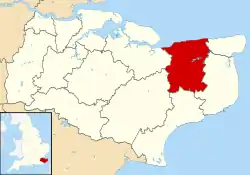Seasalter
Seasalter is a village (and district council ward) in the Canterbury District of Kent, England. It is located by the sea on the north coast of Kent, between the towns of Whitstable and Faversham, facing the Isle of Sheppey across the estuary of the River Swale. The settlement of Yorkletts is included in the ward. It is approximately five miles (8 km) north of Canterbury.
| Seasalter | |
|---|---|
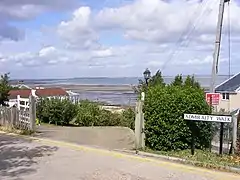 Admiralty Walk | |
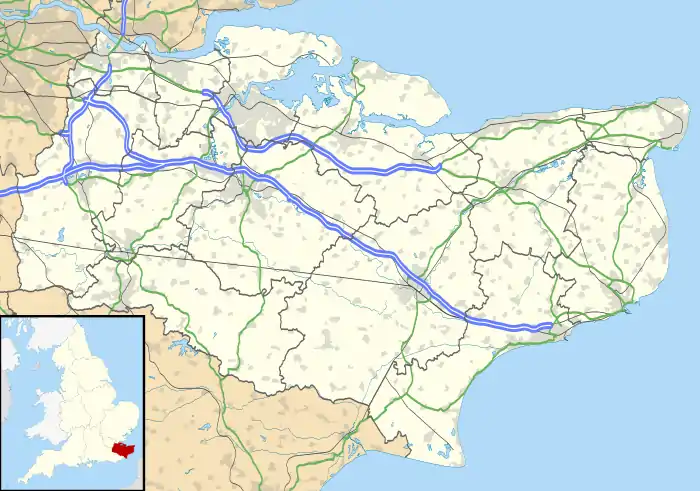 Seasalter Location within Kent | |
| Population | 7,967 (2011)[1] |
| OS grid reference | TR094653 |
| District | |
| Shire county | |
| Region | |
| Country | England |
| Sovereign state | United Kingdom |
| Post town | Whitstable |
| Postcode district | CT5 4 |
| Dialling code | 01227 |
| Police | Kent |
| Fire | Kent |
| Ambulance | South East Coast |
| UK Parliament | |
Historically, Seasalter came to prominence as a centre for salt production in the Iron Age,[2] and the resulting prosperity resulted in Viking raids on the area. Later, the Domesday Book recorded that Seasalter "properly belongs to the kitchen of the Archbishop" [of Canterbury]. The church was dedicated to a martyred Archbishop of Canterbury, Alphege (Ælfheah), first built in the 12th century, its nave was demolished in the 1840s but its chancel still stands and is a Grade II listed building.[3][4] In the 18th century, the marshes were drained to create the Seasalter Levels.[5]
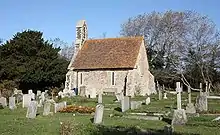
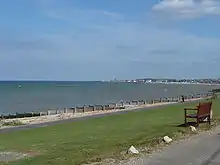
Seasalter today is primarily a residential satellite of Whitstable, and further housing development is unlikely as it is constrained by the sea, the Seasalter Flats protected marshland, and the A299 road. The beach at Seasalter is largely pebble-stone based, and therefore unpopular compared with the more sandy bays at, for example, Westgate-on-Sea. Seasalter Sailing Club, which has a clubhouse on Faversham Road, primarily hosts Catamaran boats which race on the Swale River estuary. There is also a private Water Ski Club with launch ramp, and a caravan park.
The Sportsman pub, at the western end of the village by the marshes, on a site which has hosted an inn since 1642, earned a Michelin star in 2008.[6] During the Second World War it was the billet for a company of the 1st Battalion London Irish Rifles. In September 1940 these troops happened to successfully engage the crew of a crashed German airplane on nearby Graveney Marsh, and in 2010 to mark the 70th anniversary, a commemorative plaque was unveiled at the pub.[7]
Despite the Chatham Main Line Railway passing through Seasalter, there is no station. It has long been proposed to build one, with railway maps noting a possible site; this is unlikely given the proximity of Whitstable Station. Currently the village is served by Stagecoach buses from Canterbury, Whitstable and Faversham.
Famous residents with homes or holiday houses in Seasalter include Gregg Wallace, Harry Hill and Janet Street-Porter.[8] The late Peter Cushing used to live further along the coast in Wave Crest, Whitstable.
Whitstable's Oyster Fishery uses[9] oyster beds lying in the mud approximately a mile offshore from the Seasalter shore. These are usually submerged and only revealed at low tide.
In 1976, a free rock festival was held in Seasalter after a forced move away from the chosen site in Tangmere.[10]
In 2017, the Old Brig, a well-preserved 18th century merchant ship wreck was exposed by tides near Seasalter. It is one of only three known coastal trading vessels in England from the Hanoverian period and was listed as a Scheduled Monument by Historic England in 2020.[11][12]
References
- "Ward population 2011". Retrieved 2 October 2015.
- St Alphege Church History
- "St Alphege Church, Seasalter in Whitstable - St Alphege Church, Seasalter - Part of the Anglican Whitstable Team Ministry". stalphegeseasalter.org. Retrieved 26 December 2020.
- "Seasalter Old Church, St Alphege, Non Civil Parish - 1084929 | Historic England". historicengland.org.uk. Retrieved 1 January 2021.
- History of Whitstable Shoreline
- Guardian report on Sportsman Pub
- "Kent battle between German bomber crew and British soldiers marked after 70 years". The Daily Telegraph. 20 August 2010. Retrieved 31 August 2010.
- Telegraph Article about Whitstable
- Seasalter Shellfish
- Seasalter People's Free Festival
- "Wreck of Old Brig, Non Civil Parish - 1451624 | Historic England". historicengland.org.uk. Retrieved 26 December 2020.
- "Captivating Sites Across England Listed During 2020 | Historic England". historicengland.org.uk. Retrieved 26 December 2020.
External links
| Wikimedia Commons has media related to Seasalter. |
